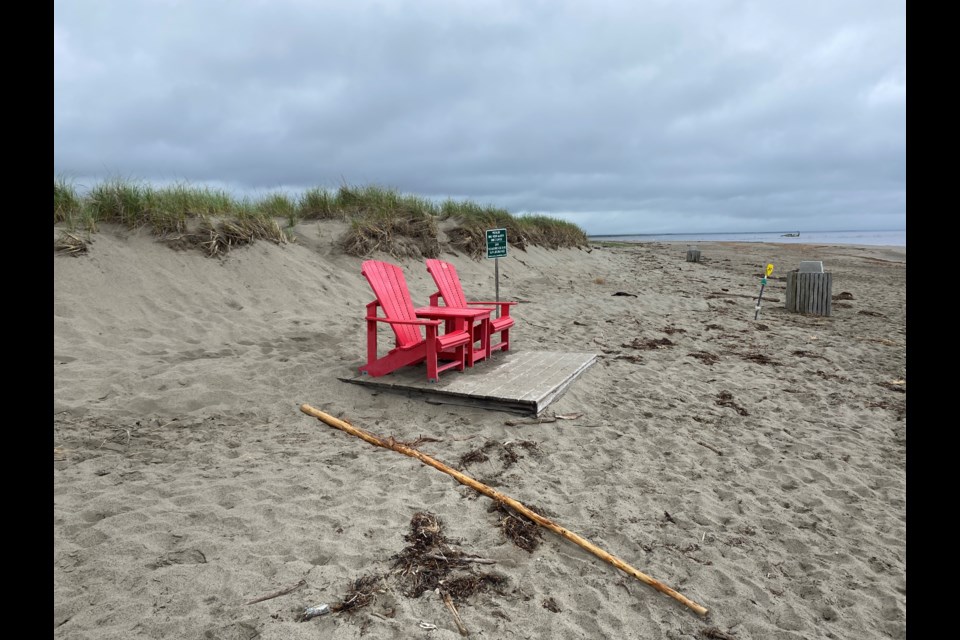Our last stop in the Maritimes was at Kouchibouguac National Park along New Brunswick’s Acadian coast. Described as featuring mixed-wood forests, salt marshes and ocean beaches, it seemed to be a wonderful area to explore.
After crossing the Confederation Bridge from Prince Edward Island, we followed the Acadian Coastal Drive for a spell, before crossing onto Hwy 15 N and then Hwy 11 towards Miramichi, New Brunswick. It was a pleasant drive and we were fortunate to have pulled in at Cap-Pele for a break and some information. This information building had a small museum which described the history of the vital herring industry of the area, and a newly opened coffee bar. The area around Cap-Pele would certainly be interesting to revisit some day.
Just north of Richibucto, we accessed Kouchibouguac (koo-chi-bu-gwac) National Park. It is quite a large park (238 square kilometres) and we had booked a campsite in the South Kouchibouguac Campground. The sites were huge compared to those at other parks we had been to. Ours was deep and well treed and we were quite content. At the time of year we were there it wasn’t too busy either. Kouchibouguac also offers a more semi-primitive campground at Cote-a-Fabien that offers breathtaking views as well as backcountry camping. Parks Canada oTENTik units are available to rent. These are described as a “spacious blend of tent and rustic cabin” and sleep six people. Parks also has three sites where they will supply everything for you to have a camping experience.
There are a number of hiking, biking and mountain bike trails throughout the park, and we were advised to make sure we visit Kelly’s Beach. The trail consists primarily of a boardwalk that leads you over a salt marsh out onto the dune structures and Kelly’s Beach.
On the boardwalk leading over the salt marsh common terns were quite active. This area boasts the second largest colony of common terns in North America. One or two were especially interesting as they repeatedly landed on the railing quite close to us. They then gazed fixedly into the waters to sight fish swimming just under the surface. Next, they would launch themselves down to catch the fish in their bill and continue flying as they swallowed their meal. This sequence was repeated several times as we watched.
Finally, the boardwalk leads to the barrier beach called Kelly’s Beach, part of the 25-kilometre stretch of the barrier island chain along the New Brunswick shoreline. As this is critical breeding ground for several at-risk species, dogs are not allowed.
The day had become overcast and as I took some photos, Claudia wandered down to the waters edge. As she walked along she spotted a Lululemon fanny pack that appeared to have been washed up on shore. Opening it, she was surprised to find a brand new iPhone turned on, a credit card that was not signed or activated, and $42 in cash.
When she showed it to me, I remembered a school group had been boarding a bus just as we started our hike. But they were long gone. Although the phone was on, we couldn’t use it to call anyone and determined to turn it in at the office later that day. A few hours later, however, a call came to the phone and the caller asked if the owner was there. Turned out it was the father of a seven-year-old girl who had left the pack on the beach during the school trip. Needless to say he was much relieved, after a long drive from Miramichi to retrieve the items, thanked us profusely.
Another trek we enjoyed was called the Bog Hike. This shorter walk takes you through a forested area leading to a tower. Upon climbing the tower you can view the continuation of the hike on a boardwalk over the bog area. Along the way we were impressed by the sight of numerous bog plants — orchids, pitcher plants, cottonwood, reindeer mosses, etc. We also learned that this bog had started to be formed before the Egyptian pyramids had been built.
With the range of natural environments, numerous trails, rich Mi’gmaq and Acadian history of this area, the park, although difficult to pronounce, is an excellent one to put on a visit list.



